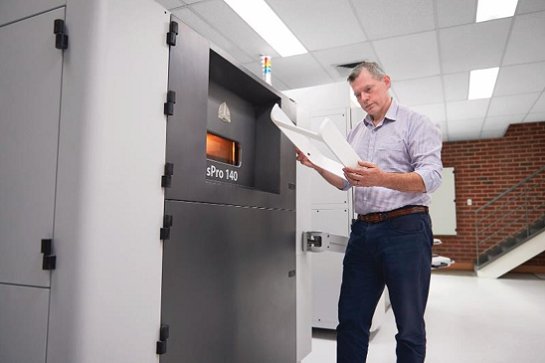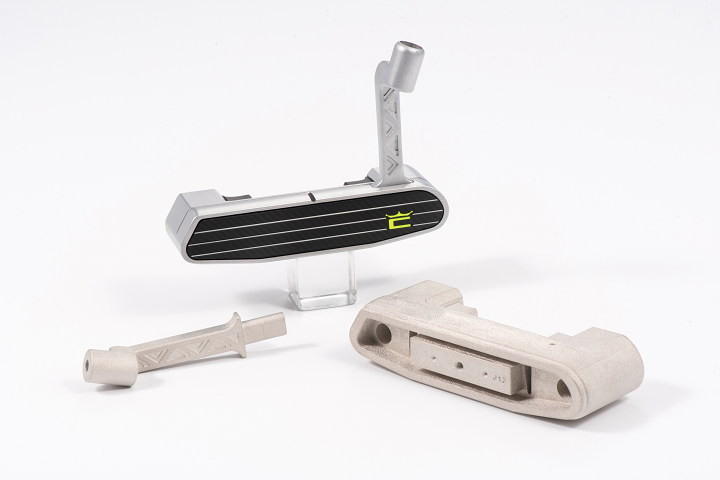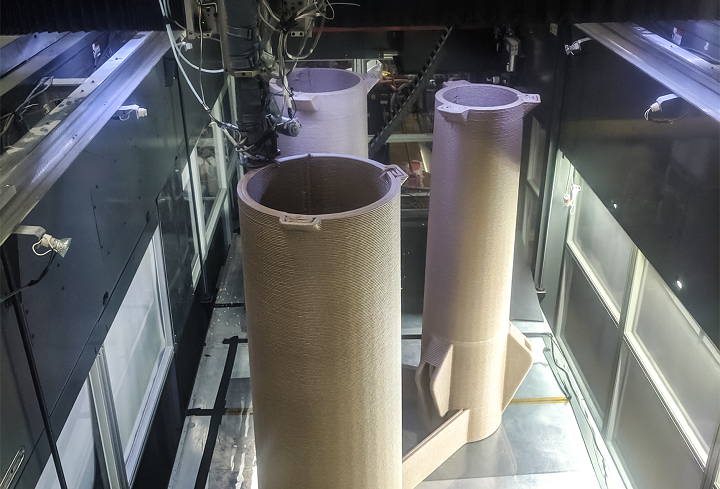3D Printing News Briefs, July 24, 2021: GoProto, Parmatech, 3DEO, & MPIF, 6K, Chris Borge, 3DQue, ORNL
In this edition of 3D Printing News Briefs, we’re starting with some business, as GoProto ANZ has announced an important industry certification, and then Parmatech, 3DEO, and 6K have each won awards for their technology. Moving on to interesting 3D printed products, a designer’s 3D printed vise can supposedly hold any shape, and ORNL 3D printed a tall pole for disaster recovery. Finally, Ender 3D printer clones are using 3DQue’s Quinly to operate autonomously.
GoProtoANZ Announces ISO Certification
 James Sanders, General Manager at GoProto ANZ, Nunawading facility, holding an SLS 3D printed part.
James Sanders, General Manager at GoProto ANZ, Nunawading facility, holding an SLS 3D printed part.Australian company GoProto ANZ, which offers custom, on-demand contract manufacturing with 3D scanning, 3D printing, sheet metal, injection molding, CNC machining, and other technologies, announced that it has been awarded ISO 9001:2015 certification for quality management. This important certification was accelerated thanks to a grant that the Centre for Defence Industry Capability awarded GoProto for its potential in manufacturing aerospace and defense components in-house, which will definitely add to the country’s “sovereign industrial capability priorities.” The exacting certification process checks out the business’s entire operations looking for quality commitment, which is important for GoProto, said to be Australia’s largest 3D printing facility.
“ISO is one of the most rigorous and well-regarded standards in the world. We sought to become certified as part of our longstanding commitment to quality and a further step of our Industry 4.0 journey. I am extremely proud of our team’s efforts, which proves their commitment to providing high quality parts and excellent customer service. We’re dedicated to constant improvement and making sure we have the processes and systems in place for this,” said James Sanders, General Manager of GoProto ANZ.
Powder Metallurgy Design Excellence Award Winners Announced
 Parmatech’s putter head and hosel for Cobra Puma Golf
Parmatech’s putter head and hosel for Cobra Puma GolfThe winners of the recent 2021 Powder Metallurgy (PM) Design Excellence Awards, sponsored by the Metal Powder Industries Federation (MPIF), have been announced, and two additive manufacturing companies won at the event. Parmatech Corporation was one of six Grand Prize winners, in the Hand Tools/Recreation Category for Metal Additive Manufactured (AM) components—using partner HP’s MJF technology, the company 3D printed a 316L stainless steel putter head and hosel for Cobra Puma Golf. Using 3D printing made it possible to optimize stiffness and mass distribution, as well as develop a unique lattice structure and create both right- and left-hand versions. 3DEO Inc. won two Awards of Distinction, with the first in the Aerospace/Military/Firearms Category for Metal AM components for its 17-4 PH stainless steel casing extractor for Glock pistols. The company also won an award in the Hand Tools/Recreation Category for the 3D printed open comb base plate in a double-edge safety razor with its customer Blackland Razors. In both applications, 3DEO used a hybrid AM approach.
“The winners in the 2021 Powder Metallurgy (PM) Design Excellence Awards competition, sponsored by the Metal Powder Industries Federation (MPIF), demonstrate outstanding examples of PM’s diversity. From electric vehicles to golf putters, these components use PM’s flexibility to push forward new concepts and process controls to demonstrate the inexhaustible well of capabilities PM can marshal in the service of component design. Designers continue to choose PM for complex and critical applications such as automotive, medical devices, consumer products, hardware, and more.”
6K’s UniMelt Plasma Awarded Top Product of the Year
 The award-winning UniMelt system from 6K
The award-winning UniMelt system from 6KSpeaking of awards, 6K, which produces sustainable advanced materials for AM powders and energy storage, announced that its UniMelt plasma production system has won a Top Product of the Year Award in the Environment + Energy Leader Awards program for its ability to more sustainably produce and deliver powders than legacy technologies. The program recognizes and awards excellence in services and products that offer companies energy and environmental benefits, as well as projects by companies that have increased the bottom line and improved environmental or energy management; 6K’s UniMelt, which uses a continuous flow operation to produce a material in just two seconds, without contaminants or yield loss, definitely fits the bill.
“We are honored that the UniMelt platform has been selected as the top product for the Environment + Energy Leader Award. UniMelt’s unique ability to leverage scrap material as a feedstock and turn it into high-value powder is just one example of our clean production approach. UniMelt’s environmentally friendly process lowers green house gases, uses significantly less energy and produces zero waste water creating a pathway to a circular or sustainable economy with performance material production,” stated Bruce Bradshaw, Chief Marketing Officer for 6K.
3D Printed Fractal Vise
South Australia-based product designer and 3D printing hobbyist Christopher Borge uses an Ender 3 printer to make DIY projects such as tools and tabletop accessories, and his latest is a 3D printed fractal vise that can hold any shape; apparently, this design idea has been making the rounds, and Borge wanted to try making his own take on the vise. Deciding to go with a twin-screw design, he looked at the patent drawings of a Hand Tool Rescue Vise restoration, made some educated guesses about the mechanicals and joinery, reverse-engineered some dimensions, and voila! The design is still a work in progress, but he posted the 3D files to Thingiverse if anyone else wants to give it a go.
“My take on the fractal vise that has been going around recently. still a WIP but it works well so far,” Borge wrote on Thingiverse.
“As always build video is not done yet but its not entirely needed this time its all pretty self explanatory. Hardware wise will need two m3*15mm bolts and two m5 bolts with a hex head as long as you can get, at least 10cm.”
ORNL Researchers 3D Printing Power Poles
 ORNL researchers demonstrated a 3D printed power pole made of bioderived and recycled materials could be easily manufactured, transported and assembled, enabling the quick restoration of power after natural disasters. Credit: ORNL, U.S. Dept. of Energy
ORNL researchers demonstrated a 3D printed power pole made of bioderived and recycled materials could be easily manufactured, transported and assembled, enabling the quick restoration of power after natural disasters. Credit: ORNL, U.S. Dept. of EnergyIn order to show that 3D printing can be used to help quickly restore electricity after natural disasters, researchers from the Oak Ridge National Laboratory (ORNL) 3D printed a 55-foot power pole using bioderived and recycled materials. Using materials that have been harvested locally, such as wood debris, to 3D print power poles makes the installation and production more efficient, which is part of what the team was trying to prove. They used the Big Area Additive Manufacturing (BAAM) system to print the pole, which was designed as a closed cylindrical structure, and also evaluated three different glass fiber composite materials: bamboo fiber reinforced polystyrene, cellulose ester, and recycled polycarbonate.
“We developed a modular design that is easy to manufacture, transport and assemble. Sections within the pole can also be customized to accommodate wires and different heights can be supported, too,” explained Halil Tekinalp, part of ORNL’s R&D Associate Staff.
Ender Clones Autonomously Printing with Quinly
Finally, 3DQue Systems Inc. has announced that based on initial testing, its 3D printer automation upgrade kit Quinly is compatible with Ender 3 clones like the Voxelab Aquila, allowing these 3D printer clones to print autonomously. Because Ender clones come with the latest hardware features, like pre-stalled upgrades, high quality stepper drivers, and silent motherboards, the printers are considered valuable by users, as these types of upgrades improve print repeatability and quality. The company is actively looking for beta testers in order to ensure compatibility with all Ender 3 clone printers, and if chosen, these beta testers can then apply for rebates on Quinly packages that have been purchased for testing.
“Recent advances in 3D printers, components, and materials make it possible for individuals to make finished, ready-for-market goods. Quinly automation eliminates the need for entrepreneurs and engineers to babysit their printers, freeing them up to focus on other priorities like family, job, and innovation,” said 3DQue Co-Founder Mateo Pekic.
You can email Ender3CloneTesting@3DQue.com if you’re interested in becoming a beta tester.
Subscribe to Our Email Newsletter
Stay up-to-date on all the latest news from the 3D printing industry and receive information and offers from third party vendors.
You May Also Like
Gorilla Sports GE’s First 3D Printed Titanium Cast
How do you help a gorilla with a broken arm? Sounds like the start of a bad joke a zookeeper might tell, but it’s an actual dilemma recently faced by...
Nylon 3D Printed Parts Made More Functional with Coatings & Colors
Parts 3D printed from polyamide (PA, Nylon) 12 using powder bed fusion (PBF) are a mainstay in the additive manufacturing (AM) industry. While post-finishing processes have improved the porosity of...
$25M to Back Sintavia’s Largest Expansion of Metal 3D Printing Capacity Since 2019
Sintavia, the digital manufacturing company specializing in mission-critical parts for strategic sectors, announced a $25 million investment to increase its production capacity, the largest expansion to its operations since 2019....
Velo3D Initiates Public Offering in a Bid to Strengthen Financial Foundations and Drive Future Growth
Velo3D (NYSE: VLD) has been among a number of publicly traded 3D printing firms that have attempted to weather the current macroeconomic climate. After posting a challenging financial report for 2023,...

































